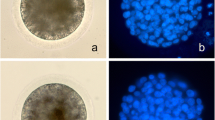Abstract
Purpose
The purposes of the present study are to assess the clinical efficiency of Piezo-intracytoplasmic sperm injection (ICSI) and to improve the Piezo-ICSI method for human oocytes.
Methods
We examined three ICSI methods to determine their clinical efficiency by comparing the survival, fertilization, good-quality day-3 embryo, pregnancy, and live birth rates. The three ICSI methods tested were conventional ICSI (CI) (using beveled spiked micropipettes with a wall thickness of 1 μm), conventional Piezo-ICSI (CPI) (using flat-tipped micropipettes with a wall thickness of 0.925 μm), and improved Piezo-ICSI (IPI) (using flat-tipped micropipettes with a wall thickness of 0.625 μm). We collectively investigated 2020 mature oocytes retrieved from 437 patients between October 2010 and January 2014.
Results
The survival rates after CI, CPI, and IPI were 90, 95, and 99 %, respectively. The fertilization rates after CI, CPI, and IPI were 68, 75, and 89 %, respectively. The good-quality day-3 embryo rates after CI, CPI, and IPI were 37, 43, and 55 %, respectively. The pregnancy rates after the transfer of good-quality day-3 embryo of CI, CPI, and IPI were 19, 21, and 31 %, respectively. The live birth rates of CI, CPI, and IPI were 15, 16, and 25 %, respectively. Significantly higher survival, fertilization, good-quality day-3 embryo, pregnancy, and live birth rates were obtained using IPI.
Conclusions
When comparing the IPI to the CI and CPI, the results revealed that the Piezo-ICSI using flat-tipped micropipettes with a wall thickness of 0.625 μm significantly improves survival, fertilization, good-quality day-3 embryo, pregnancy, and live birth rates.



Similar content being viewed by others
References
Palermo G, Joris H, Devroey P, Van Steirteghem AC. Pregnancies after intracytoplasmic injection of single spermatozoon into an oocyte. Lancet. 1992;340:17–8.
Kimura Y, Yanagimachi R. Intracytoplasmic sperm injection in the mouse. Biol Reprod. 1995;52:709–20.
Huang T, Kimura Y, Yanagimachi R. The use of piezo micromanipulation for intracytoplasmic sperm injection of human oocytes. J Assist Reprod Genet. 1996;13:320–8.
Yanagida K, Katayose H, Yazawa H, Kimura Y, Konnai K, Sato A. The usefulness of a piezo-micromanipulator in intracytoplasmic sperm injection in humans. Hum Reprod. 1999;14:448–53.
Takeuchi S, Minoura H, Shibahara T, Shen X, Futamura N, Toyoda N. Comparison of piezo-assisted micromanipulation with conventional micromanipulation for intracytoplasmic sperm injection into human oocytes. Gynecol Obstet Investig. 2001;52:158–62.
Ferraretti AP, Gianaroli L, Magli MC, Devroey P. Mild ovarian stimulation with clomiphene citrate launch is a realistic option for in vitro fertilization. Fertil Steril. 2015. doi:10.1016/j.fertnstert.2015.05.006.
Diedrich K, Diedrich C, Santos E, Zoll C, al-Hasani S, Reissmann T, et al. Suppression of the endogenous luteinizing hormone surge by the gonadotrophin-releasing hormone antagonist Cetrorelix during ovarian stimulation. Hum Reprod. 1994;9(5):788–91.
Kuwayama M, Vajta G, Ieda S, Kato O. Comparison of open and closed methods for vitrification of human embryos and the elimination of potential contamination. Reprod Biomed Online. 2005;11:608–14.
Hiraoka K, Hiraoka K, Horiuchi T, Kusuda T, Okano S, Kinutani M, et al. Impact of the size of zona pellucida thinning area on vitrified-warmed cleavage-stage embryo transfers: a prospective, randomized study. J Assist Reprod Genet. 2009;26:515–21.
Dumoulin JM, Coonen E, Bras M, Bergers-Janssen JM, Ignoul-Vanvuchelen RC, van Wissen LC, et al. Embryo development and chromosomal anomalies after ICSI: effect of the injection procedure. Hum Reprod. 2001;16:306–12.
Abdelmassih S, Cardoso J, Abdelmassih V, Dias JA, Abdelmassih R, Nagy ZP. Laser-assisted ICSI: a novel approach to obtain higher oocyte survival and embryo quality rates. Hum Reprod. 2002;17:2694–9.
Ebner T, Moser M, Sommergruber M, Jesacher K, Tews G. Complete oocyte activation failure after ICSI can be overcome by a modified injection technique. Hum Reprod. 2004;19:1837–41.
Richter KS, Davis A, Carter J, Greenhouse SJ, Mottla GL, Tucker MJ. No advantage of laser-assisted over conventional intracytoplasmic sperm injection: a randomized controlled trial. J Exp Clin Assist Reprod. 2006;3:5.
De Vos A, Van Landuyt L, Van Ranst H, Vandermonde A, D’Haese V, Sterckx J, et al. Randomized sibling-oocyte study using recombinant human hyaluronidase versus bovine-derived Sigma hyaluronidase in ICSI patients. Hum Reprod. 2008;23:1815–9.
Acknowledgments
We are indebted to Ms. Adair Oesterle for her critical reading of the manuscript.
Author information
Authors and Affiliations
Corresponding author
Ethics declarations
Conflict of interest
The authors declare that they have no conflict of interest.
Ethical approval
All procedures performed in studies involving human participants were in accordance with the ethical standards of the institutional and/or national research committee and with the 1964 Helsinki declaration and its later amendments or comparable ethical standards. For this type of study, formal consent is not required.
Informed consent
Informed consent was obtained from all individual participants included in the study.
Additional information
Capsule Piezo-ICSI, in combination with flat-tipped micropipettes with a wall thickness of 0.625 μm, significantly improves survival, fertilization, good-quality day-3 embryo, pregnancy, and live birth rates as compared to conventional ICSI.
Rights and permissions
About this article
Cite this article
Hiraoka, K., Kitamura, S. Clinical efficiency of Piezo-ICSI using micropipettes with a wall thickness of 0.625 μm. J Assist Reprod Genet 32, 1827–1833 (2015). https://doi.org/10.1007/s10815-015-0597-9
Received:
Accepted:
Published:
Issue Date:
DOI: https://doi.org/10.1007/s10815-015-0597-9




